Categorisation of Requirements in the Ontology-Based Framework for Employer Information Requirements (OntEIR)
Abstract
1. Introduction: Requirements and Requirements Categorisation
2. Categorising Employer Information Requirements in OntEIR
- The Common Data Environment (CDE) and the roles and responsibilities of all the team members of the project, including the client.
- The project stages in terms of project requirement for each stage, the Asset Information Requirements (AIR) for each stage, and the maturity level of each stage defined by the Level of Definition (LOD) and Level of Information (LOI) of the deliverables.
- Data Drops: these are the deliverables that should be presented to the client at the end of each stage, which include the requirements defined by the client in the EIR; at the end of each data drop, the Project Information Model (PIM) develops until reaching fully mature AIM model; in the final stage, ‘Hand over’.
- The client decision points, which are connected to the data drops, in which the client decides to progress to the next stage or not.
- As well as the information exchange requirements which are an important part of the delivery cycle because it guides the information exchanged between the different team players and the information exchanged with the client as well.
2.1. Static Needs (Cluster 1)
- -
- Tasks (responsibilities): BIM roles and responsibilities which inform the RACI table for the project (Responsible for, Authorising, Consulted by, and Informed by)
- -
- Roles: defines the different roles that are involved in the project, the names of the individuals, and the contact details
- -
- Standards: defines the standards that will be used in the project
- -
- Ownership of the model: defines the ownership and the licensing of the model in the different stages of the project
- -
- Data security measures: the measures that should be undertaken by the team to ensure data security in terms of cyber security
- -
- Software platforms: the different software platforms and versions that will be used during the project
- -
- Coordinates: clarify the relationship between the origin and orientation and the ordinance survey grid and local project grid
- -
- Communication: Coordination and clash detection
- -
- AIM delivery strategy: BIM information exchange formats and classification systems
2.2. Dynamic Needs (Cluster 2)
- -
- Data drops: data submitted to the client at each stage
- -
- Project team: the roles that will be involved in each stage
- -
- Project requirements: information that is added to the model at each stage
- -
- LOD and LOI: Level of Detail and Level of Information for the different components at each stage
- -
- AIR: the Asset Information Requirements required by the client, which informs the AIM
- -
- CDM data drops: health and safety data that is submitted at each stage and that adheres to the Construction and Design Management Regulations (CDM)
- -
- Data security level: a label added to the information to determine the level of security and confidentiality.
- -
- COBie: Construction Operations Building Information Exchange is the information to be added to the BIM model that contains the operation and maintenance information for the different assets.
3. Evaluation of the Static and Dynamic Categorisation of Requirements
3.1. Purpose of Evaluation
- The justification of the use of static and dynamic requirements in the categorisation of the EIR;
- How successful was the categorisation system in OntEIR in enhancing the clarity and comprehensiveness of the EIR;
- The completeness of the EIR in terms of both the static and dynamic needs in covering all the related requirements.
3.2. Methods Applied
3.2.1. Interviews and Survey
- -
- 9 Likert-scale questions, in which the categories of ratings include: 1 (Highly Disagree), 2 (Disagree), 3 (Neutral), 4 (Agree), and 5 (Highly agree); and 17 open-ended questions, in which the participant would have more freedom in answering the questions.
3.2.2. Selection of Participants
- Having extensive working or academic experience with BIM Clients, BIM EIR specifications, Procurement or Building Information Modelling, with a five-year or more experience working in BIM;
- Recent and direct involvement in the specifications of the Employer Information Requirements for BIM Projects, and client requirements, the participant should have been involved in specifying or translating at least 10 EIRs/BEP in the last five years;
- Having a sound knowledge and understanding of client requirements, information requirements, and Procurement or Building information modelling within the U.K, which is translated into having over five years of experience in BIM requirements, specification of client requirements, and/or the procurement process.
3.2.3. Focus Groups
3.2.4. Descriptive Statistics
3.2.5. Relative Importance Index
3.2.6. Responses to Questions
3.2.7. Suggestions for Improvements and Other Comments
- -
- Communication: Coordination and Clash Detection
- -
- Asset Information Model (AIM) Delivery Strategy
- Data loss: This is due to the way information is stored and exchanged.
- Workload; and
- Revealing defects after they appear.
- -
- CDE: in which the Common Data Environment is defined.
- -
- Frequency of information exchange.
- -
- Clash detection process.
- -
- Clash resolution process.
- -
- Clash detection responsibility.
- -
- Other communication fields that the client feels should be defined.
- -
- Information exchange format.
- -
- Standard classification system; and
- -
- Computer Aided Facility Management (CAFM) software.
- -
- Project stages.
- -
- Asset Information Requirements (AIR) and the COBie deliverables.
- -
- Definition of LOD and LOI.
4. Discussion
- Enhancing the understandability and clarity of the requirements needed for a complete EIR.
- Enhancing collaboration through the categorisation of requirements which allows stakeholders to access the information they need [16].
- Moreover, incorporating stages and defining their own dynamic requirements makes it easier in the early consideration of lifecycle issues and requirements [43]
- The consideration of requirements in early stages of the project that would affect the lifecycle of the project and facility [43]
5. Conclusions
Author Contributions
Funding
Conflicts of Interest
References
- Robertson, S.; Robertson, J. Mastering the Requirements Process: Getting Requirements Right; Addison-Wesley: Boston, MA, USA, 2012. [Google Scholar]
- Office of Government Commerce, UK, Requirements Management. Available online: http://webarchive.nationalarchives.gov.uk/20100609111548/http://www.ogc.gov.uk/delivery_lifecycle_requirements_management.asp (accessed on 25 September 2022).
- Fiksel, J.; Dunkle, M. Principles of requirement management automation. In Combined Proceedings of the Leesburg Workshops on Reliability and Maintainability Computer-Aided Engineering in Concurrent Engineering; IEEE: Piscatway, NJ, USA, 1990; pp. 231–236. [Google Scholar]
- Walker, A. Project Management in Construction; John Wiley & Sons: New York, NY, USA, 2015. [Google Scholar]
- Sebastian, R. Changing roles of the clients, architects and contractors through BIM. Eng. Constr. Archit. Manag. 2011, 18, 176–187. [Google Scholar] [CrossRef]
- Chartered Institute of Building (CIOB). A Report Exploring Procurement in the Construction Industry; Chartered Institute of Building (CIOB): Bracknell, UK, 2010. [Google Scholar]
- Chartered Institute of Building (CIOB). Code of Practice for Project Management for Construction and Development; Wiley & Sons: New York, NY, USA, 2014. [Google Scholar]
- British Standards Institution. 2013. PAS 1192-2: 2013 Specification for Information Management for the Capital/Delivery Phase of Construction Projects Using Building Information Modelling; British Standards Institution: London, UK, 2013. [Google Scholar]
- Ashworth, S.; Tucker, M.; Druhmann, C. Employer’s Information Requirements (EIR): A BIM case study to meet client and facility manager needs. In Eurofm’s 16th Research Symposium Efmc 2017; Nielsen, S., Jensen, P., Brinkø, R., Eds.; Polyteknisk Boghandel og Forlag: Madrid, Spain, 2017. [Google Scholar]
- Phillips-Alonge, O. The influence of partnering on the occurrence of construction requirement conflicts and disputes. Int. J. Constr. Manag. 2019, 19, 291–306. [Google Scholar] [CrossRef]
- Sun, M.; Aouad, G. Integration technologies to support organisational changes in the construction industry. In Proceedings of the 7th ISPE International Conference on Concurrent Engineering, Lyon, France, 17–20 July 2000; pp. 596–604. [Google Scholar]
- Noor, R.; Husna, R.; Ibrahim, C.; Izam, C.; Belayutham, S. The nexus of key attributes influencing the social collaboration among BIM actors: A review of construction literature. Int. J. Constr. Manag. 2021, 1–11. [Google Scholar]
- Dick, J.; Hull, E.; Jackson, K. Requirements Engineering; Springer: Berlin/Heidelberg, Germany, 2017. [Google Scholar]
- Buede, D.; Miller, W. The Engineering Design of Systems: Models and Methods; John Wiley & Sons: New York, NY, USA, 2016. [Google Scholar]
- Jain, R.; Chandrasekaran, A.; Elias, G.; Cloutier, R. Exploring the impact of systems architecture and systems requirements on systems integration complexity. IEEE Syst. J. 2008, 2, 209–223. [Google Scholar] [CrossRef]
- Kupersmith, K.; Mulvey, P.; McGoey, K. Buisiness Analysis for Dummies, 1st ed.; John Wiley & Sons, Inc.: Toronto, ON, Canada, 2013. [Google Scholar]
- Halligan, R. Requirements metrics: The basis of informed requirements engineering management. In Proceedings of the 1993 Complex Systems Engineering Synthesis and Assessment Technology Workshop (CSESAW ’93), Calvados MD, USA; Available online: https://www.ppi-int.com/wp-content/uploads/2020/06/PPA-005330-11-Requirements-Quality-Metrics-170531.pdf (accessed on 30 October 2022).
- Sommerville, I.; Sawyer, P. Requirements Engineering, A Good Practice Guide; John Wiley & Sons: Chichester, UK, 1997. [Google Scholar]
- Sommerville, I. Software Engineering; Global, T., Ed.; Pearson Education Limited: Harlow, UK, 2016. [Google Scholar]
- Kamara, J.; Anumba, C.; Evbuomwan, N. Capturing Client Requirements in Construction Projects; Thomas Telford Ltd.: London, UK, 2002. [Google Scholar]
- Kiviniemi, A.; Fischer, M.; Bazjanac, V.; Paulson, B. PREMISS-Requirements management interface to building product models: Problem definition and research issues. CIFE Work. Pap. 92 2004. [Google Scholar]
- Saxon, R. BIM for Construction Clients: Driving Strategic Value through Digital Information Management; NBS: Newcastle upon Tyne, UK, 2016. [Google Scholar]
- Kovacs, A.; Micsik, A. BIM quality control based on requirement linked data. Int. J. Archit. Comput. 2021, 19, 431–448. [Google Scholar] [CrossRef]
- Dwairi, S.; Mahdjoubi, L.; Odeh, M.; Kossmann, M. Development of OntEIR framework to support BIM clients in construction. Int. J. 3-D Inf. Model. 2016, 5, 45–66. [Google Scholar] [CrossRef]
- Dwairi, S. Development of an Ontology-based Framework and Tool for Employer Information Requirements (OntEIR). Ph.D. Thesis, University of the West of England, Bristol, UK, 2018. [Google Scholar]
- Van Lamsweerde, A.; Letier, E. Integrating obstacles in goal-driven requirements engineering. In Proceedings of the 20th International Conference on Software Engineering, Kyoto, Japan, 19–25 April 1998; pp. 53–62. [Google Scholar]
- Mylopoulos, J.; Chung, L.; Yu, E. From object-oriented to goal-oriented requirements analysis. Commun. ACM 1999, 42, 31–37. [Google Scholar] [CrossRef]
- Van Lamsweerde, A. Requirements engineering in the year 00: A research perspective. In Proceedings of the 22nd International Conference on Software Engineering, Limerick, Ireland, 4–11 June 2000; pp. 5–19. [Google Scholar]
- Endsley, M.; Bolstad, C.; Jones, D.; Riley, J. Situation awareness oriented design: From user’s cognitive requirements to creating effective supporting technologies. In Proceedings of the Human Factors and Ergonomics Society Annual Meeting; SAGE: Los Angeles, CA, USA, 2003; Volume 47, pp. 268–272. [Google Scholar]
- Irizarry, J.; Gheisari, M. Situation awareness (SA), a qualitative user-centered information needs assessment approach. Int. J. Constr. Manag. 2013, 13, 35–53. [Google Scholar] [CrossRef]
- Bradley, A.; Li, H.; Lark, R.; Dunn, S. BIM for infrastructure: An overall review and constructor perspective. Autom. Constr. 2016, 71, 139–152. [Google Scholar] [CrossRef]
- Koutamanis, A. Briefing and building information modelling: Potential for integration. Int. J. Archit. Comput. 2017, 15, 119–133. [Google Scholar] [CrossRef]
- Taylor, R.; Judd, L. Delphi method applied to tourism. Delphi Method Applied to Tourism; Prentice Hall: London, UK, 1989; pp. 95–98. [Google Scholar]
- Robson, C. Real world research: A resource for social scientists and practitioner. In Adapting Open Innovation in ICT Ecosystem Dynamics References Real World Research: A Resource for Social Scientists and Practitioner; Wiley-Blackwell: Hoboken, NJ, USA, 2002; p. 270. [Google Scholar]
- Denscombe, M. The Good Research Guide: For Small-Scale Social Research Projects; McGraw-Hill Education: New York, NY, USA, 2017. [Google Scholar]
- Bell, E.; Bryman, A.; Harley, B. Business Research Methods; Oxford University Press: Oxford, UK, 2022. [Google Scholar]
- Gray, P.; Williamson, J.; Karp, D.; Dalphin, J. The Research Imagination: An Introduction to Qualitative and Quantitative Methods; Cambridge University Press: Cambridge, UK, 2007. [Google Scholar]
- Gray, D. Doing Research in the Real World, 3rd ed.; Sage: London, UK, 2014. [Google Scholar]
- Naoum, S. Dissertation Research and Writing for Construction Students; Routledge: London, UK, 2012. [Google Scholar]
- Dubas, S.; Pasławski, J. The concept of improving communication in BIM during transfer to operation phase on the Polish market. Procedia Eng. 2017, 208, 14–19. [Google Scholar] [CrossRef]
- Park, C.; Lee, D.; Kwon, O.; Wang, X. A framework for proactive construction defect management using BIM, augmented reality and ontology-based data collection template. Autom. Constr. 2013, 33, 61–71. [Google Scholar] [CrossRef]
- Miller, R. 10 Clients as innovation drivers in large engineering projects. In Clients Driving Innovation; John Wiley & Sons: New York, NY, USA, 2009; p. 88. [Google Scholar]
- Kamara, J.; Anumba, C. ClientPro: A prototype software for client requirements processing in construction. Adv. Eng. Softw. 2001, 32, 141–158. [Google Scholar] [CrossRef]
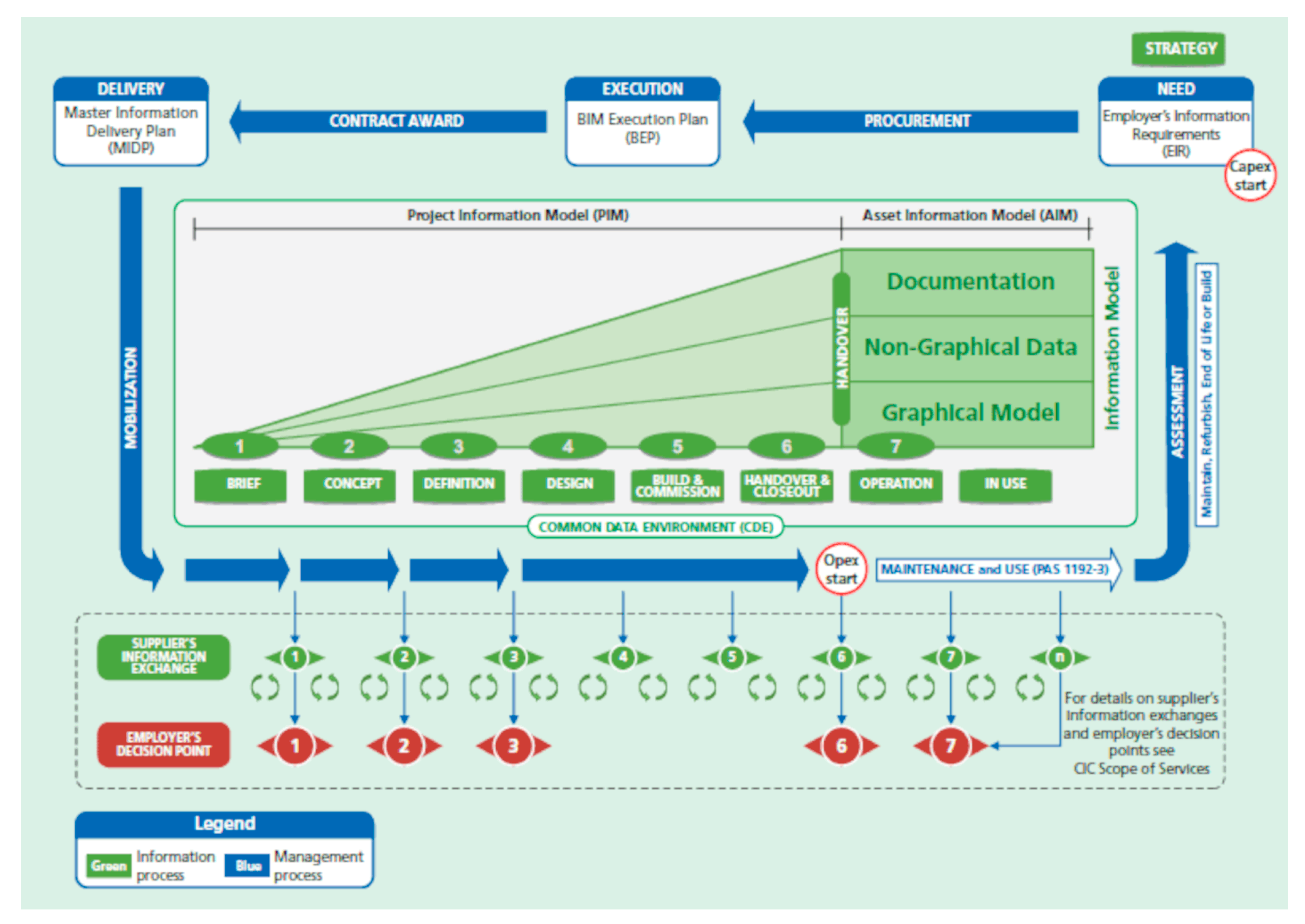
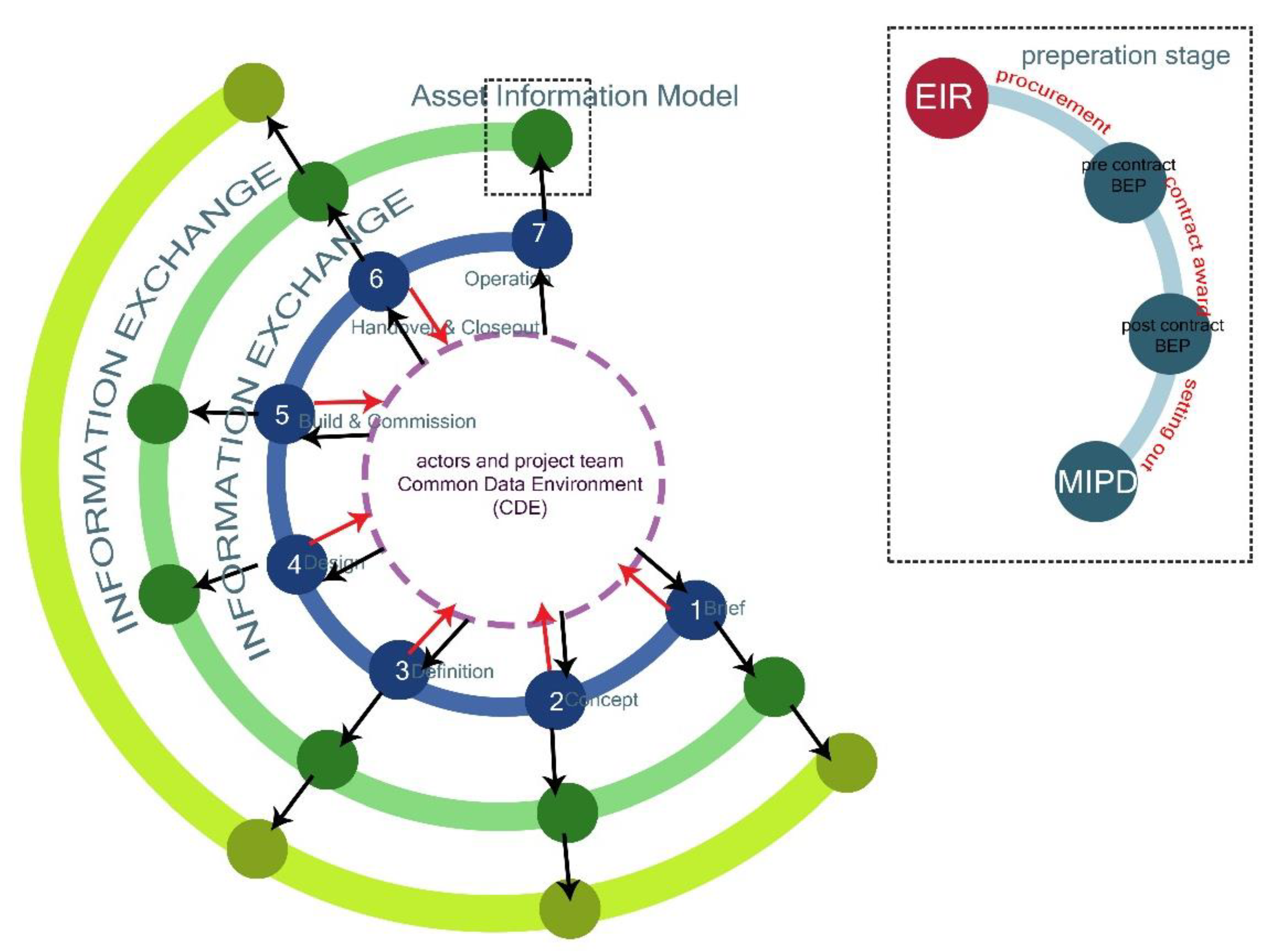
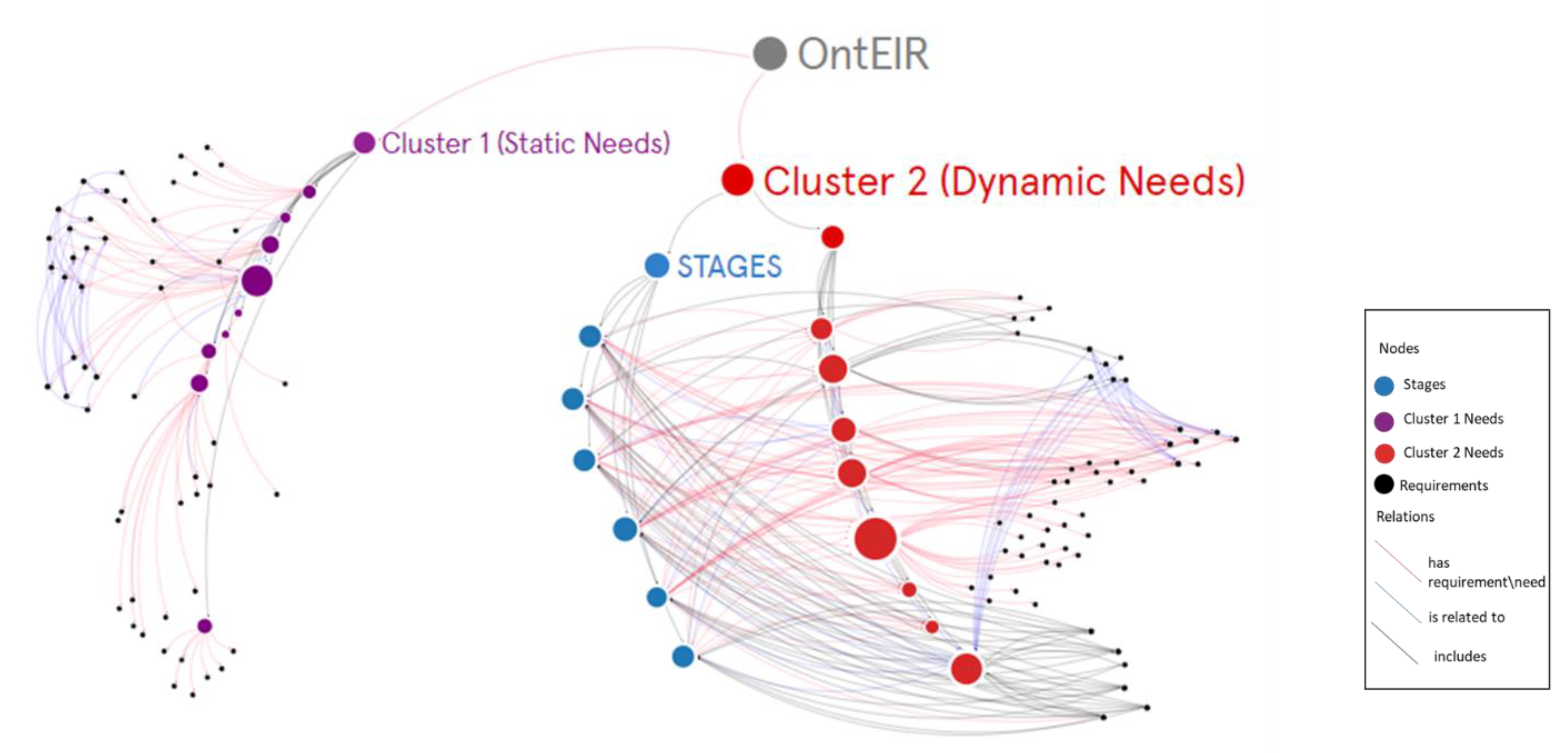
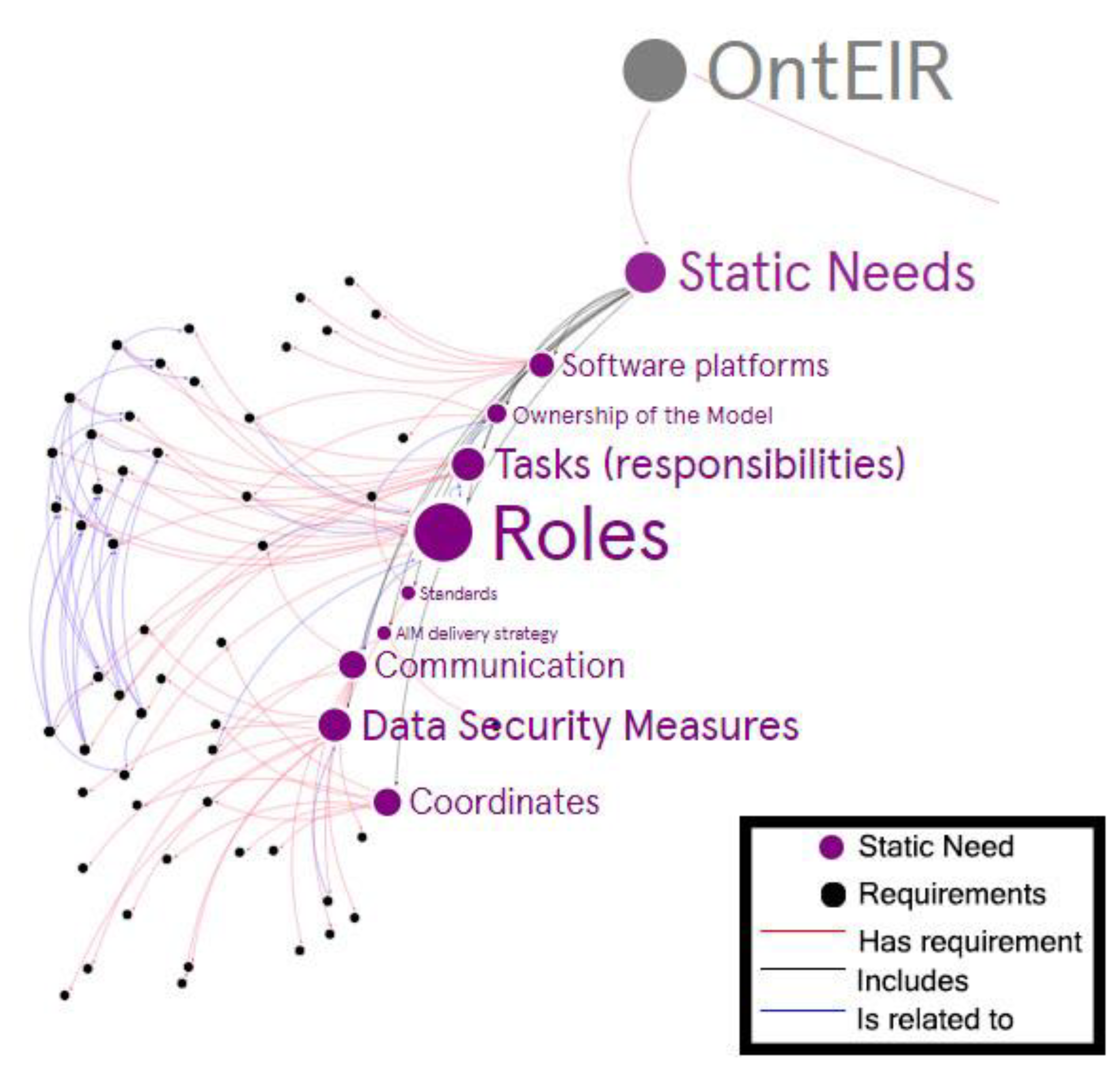
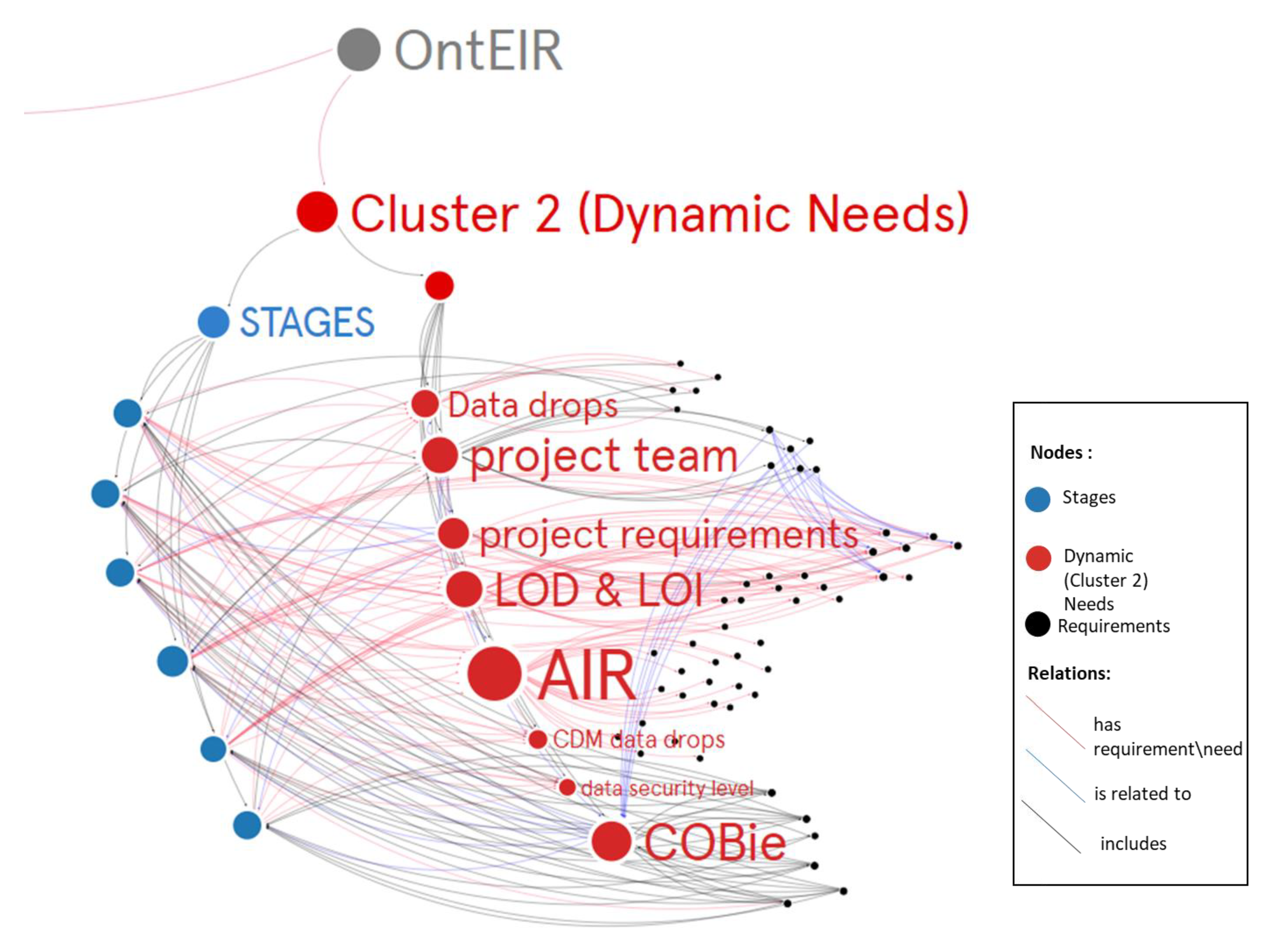
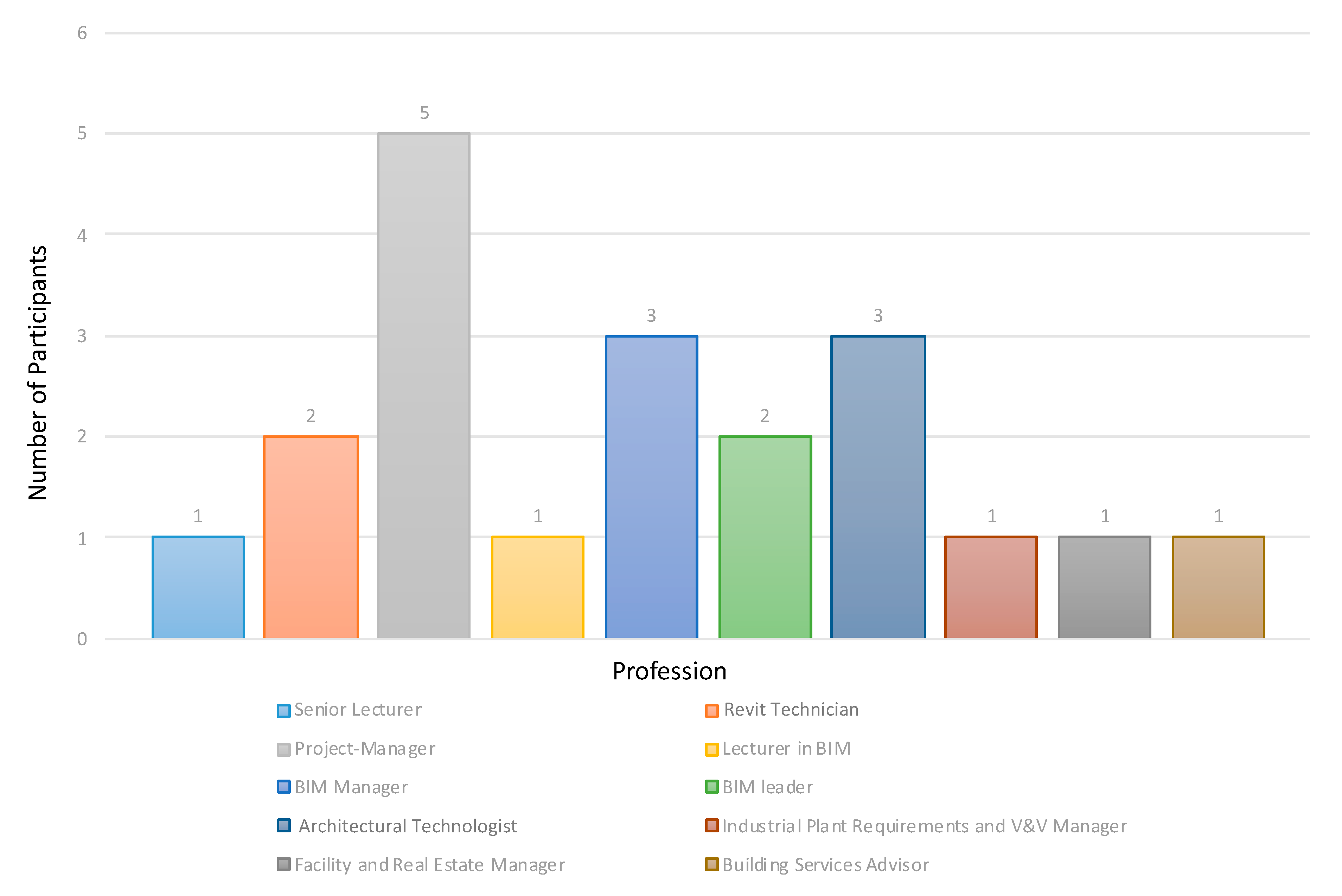
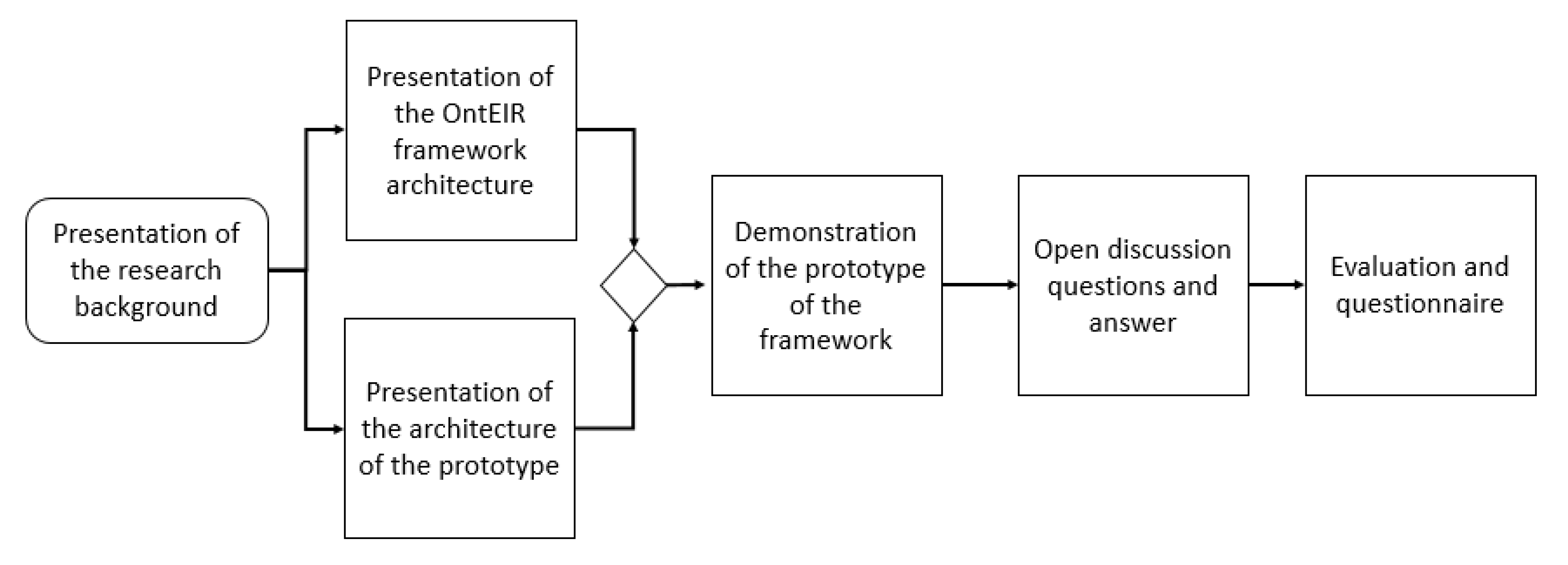
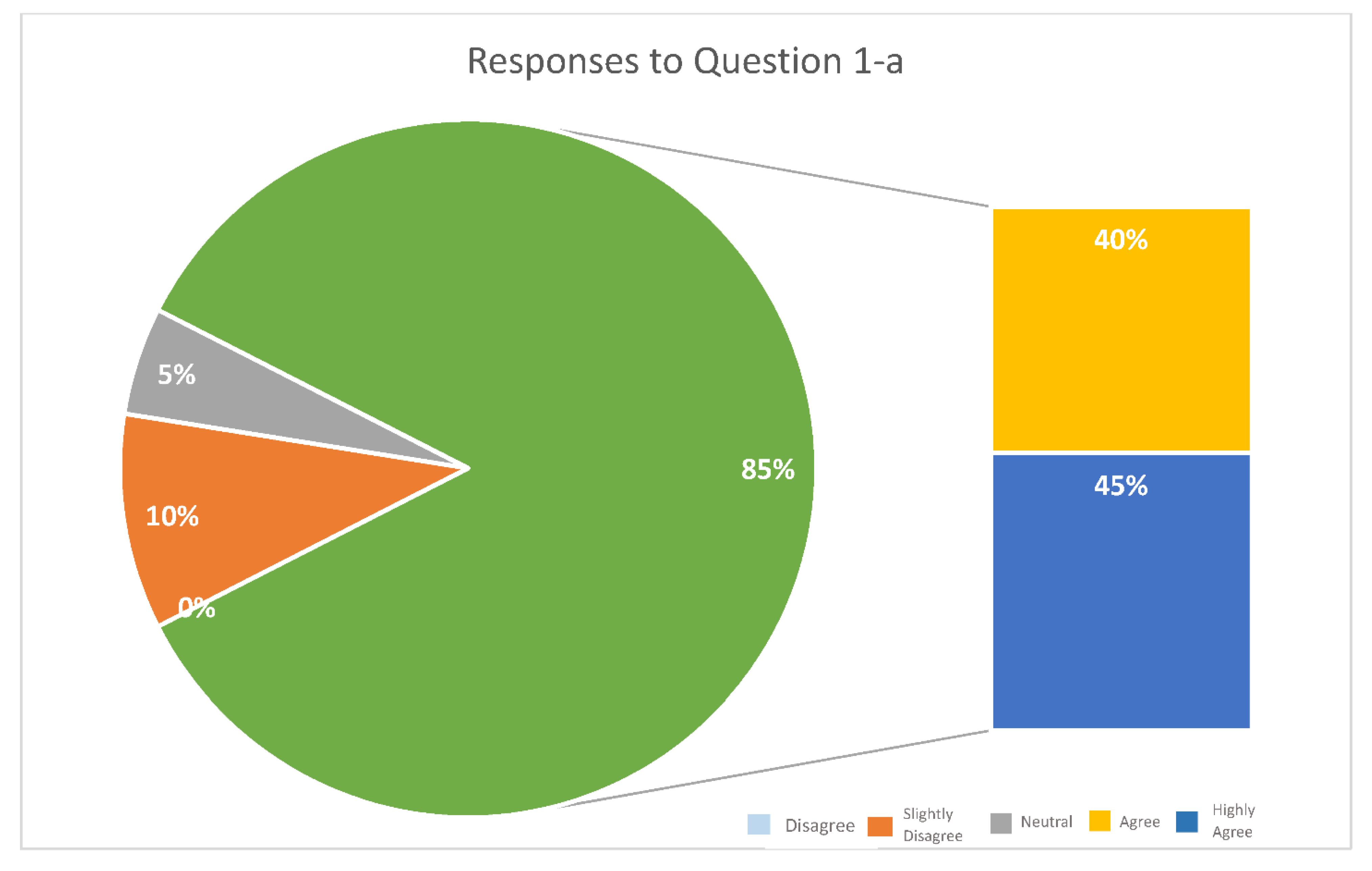
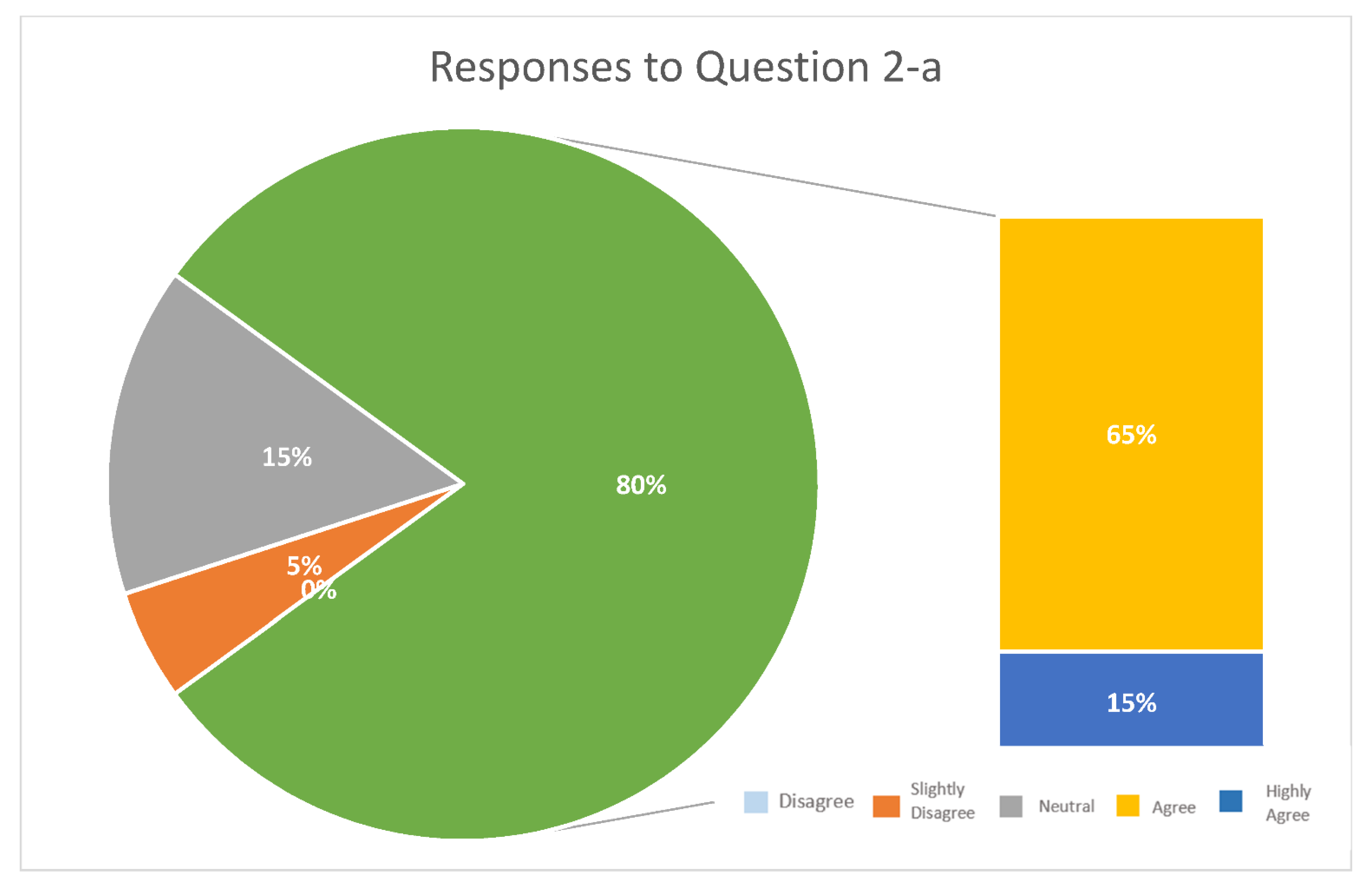


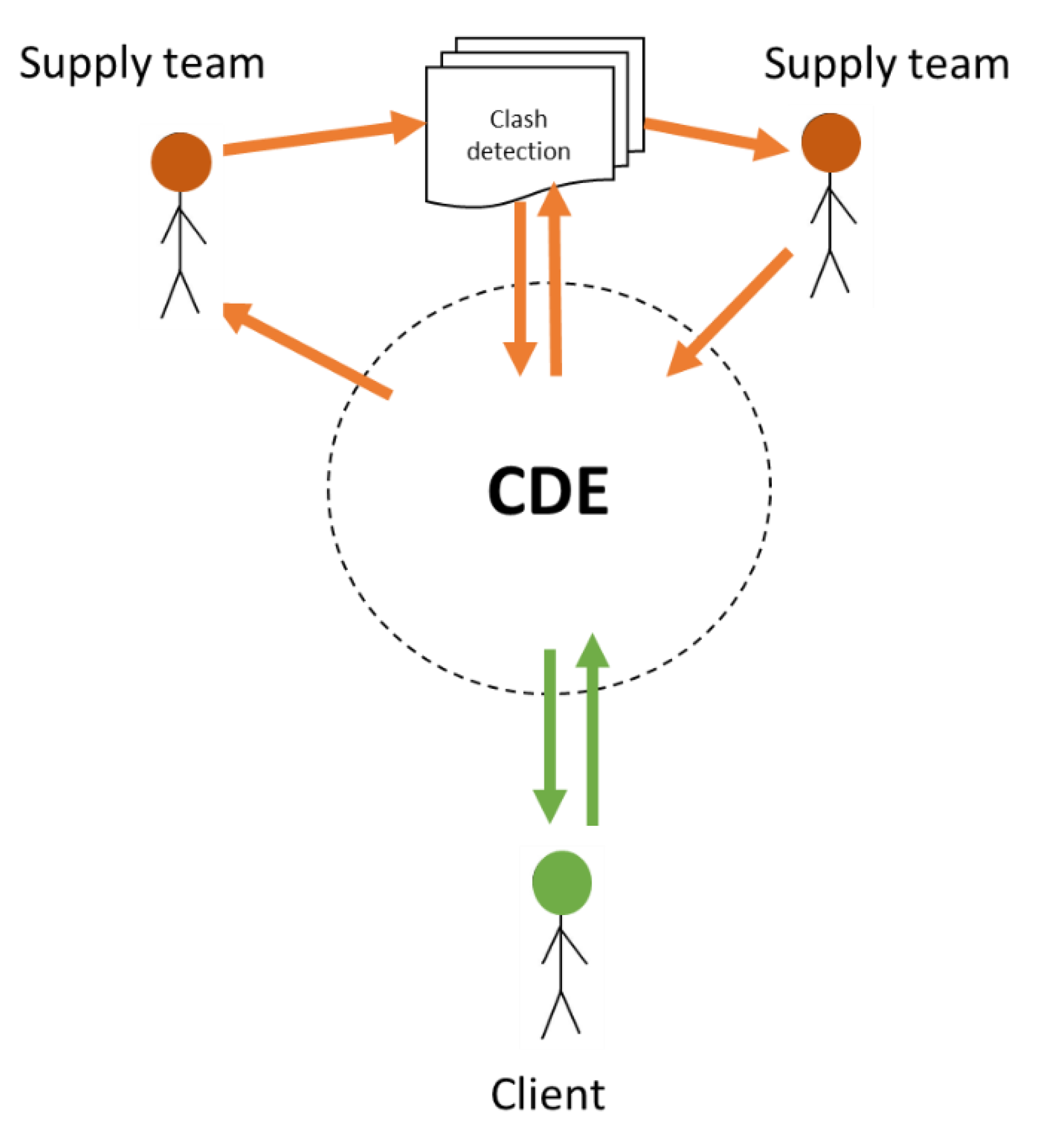
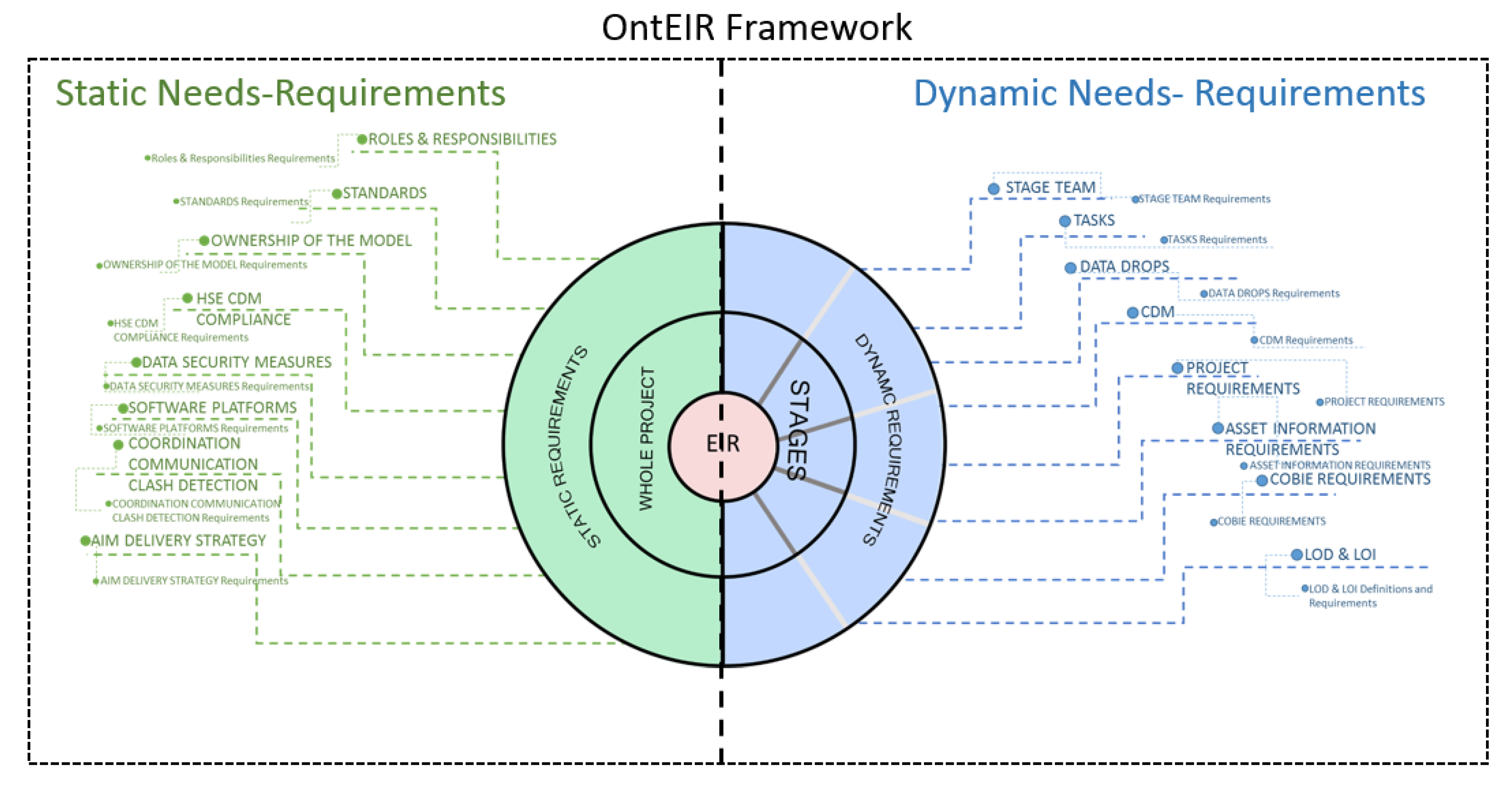
| Participant ID | Title | Area of Business |
|---|---|---|
| R1-1 | Project-Manager | Facility Management // Buildings and Construction |
| R1-2 | AutoCAD Assistant | Space Management and Master Planning |
| R1-3 | BIM Manager | Client-Higher Education |
| R1-4 | Lecturer in BIM | BIM and Project Management |
| R1-5 | Project Manager | BIM and Project Management |
| R1-6 | BIM Manager | Main Contractor |
| R1-7 | Building Services Advisor | Central Government |
| R1-8 | Revit Technician | Engineering |
| R1-9 | Architectural Technologist | Construction |
| R1-10 | BIM Leader | BIM Smart Cities |
| R1-11 | BIM Manager | Architecture |
| R1-12 | Senior Lecturer | Architecture and Construction |
| R1-13 | BIM Leader | Smart Cities |
| R1-14 | Architectural Technologist | Construction |
| R1-15 | Revit Technician | Engineering |
| R1-16 | Requirements Manager | Requirements Management, Validation and Verification Management |
| R1-17 | Facility and Real Estate Manager | Office and Manufacturing Buildings and Related Services. |
| R1-18 | Construction Project Manager | Industrial Facilities and Services |
| R1-19 | Project Manager | Manufacturing Engineering |
| R1-20 | Project Manager | Construction |
| Participant ID | Role |
|---|---|
| FG1 | Facilities Manager |
| FG2 | Facilities Manager |
| FG3 | Facilities Manager and Construction Project Manager |
| FG4 | Facilities Processes and BIM Expert |
| FG5 | Facilities Processes and BIM Expert |
| FG6 | Construction Project Manager (Facilities) |
| FG7 | Client (Manufacturing facilities) |
| FG8 | Construction Project Manager (Manufacturing facilities) |
| FG9 | Client (Manufacturing facilities) |
| Mean | S.D | Degree of Agreement | |||
|---|---|---|---|---|---|
| Highly Disagree | Disagree | Agree | Highly Agree | ||
| 4.20 | 0.93 |  | |||
| Mean | S.D | Degree of Agreement | |||
|---|---|---|---|---|---|
| Highly Disagree | Disagree | Agree | Highly Agree | ||
| 3.90 | 0.70 |  | |||
| Mean | S.D | Degree of Agreement | |||
|---|---|---|---|---|---|
| Highly Disagree | Disagree | Agree | Highly Agree | ||
| 3.60 | 0.66 |  | |||
| Mean | S.D | Degree of Agreement | |||
|---|---|---|---|---|---|
| Highly Disagree | Disagree | Agree | Highly Agree | ||
| 3.95 | 0.74 |  | |||
| OntEIR Evaluation Criteria | Question | Mean | RII | RII Value | Degree of Agreement | |||
|---|---|---|---|---|---|---|---|---|
| Highly Disagree | Disagree | Agree | Highly Agree | |||||
| Categorisation | Do you agree that the categorisation between static and dynamic requirements is right for EIR? | 4.20 | 0.765 | Very High |  | |||
| Categorisation (Mean: 4.20 = Highly Agree, RII: 0.765 = Very High) | ||||||||
| Comprehensiveness | How comprehensive is the OntEIR framework in defining the requirements for EIR? | 3.90 | 0.72 |  | ||||
| Comprehensiveness (Mean 3.9 = Highly Agree, RII: 0.72 = High) | ||||||||
| Completeness | Do static requirements contain the right level of needs? | 3.6 | 0.54 | Low |  | |||
| Does the dynamic section contain the right level of needs? | 3.95 | 0.78 | Very High |  | ||||
| Completeness (Mean = 3.775 = Agree, RII: 0.66 = low) | ||||||||
| Question | Remarks | Sample Quotes |
|---|---|---|
| In the static section, what requirements should be added? | CDE Clash detection frequency AIM delivery strategy | |
| In the static section, what requirements should be removed? | All participants answered with “None” | |
| In the dynamic section, what requirements should be added? | More detail in the Asset Information Requirements Classification system to be used should be specified (UniClass, NRM…) | |
| In the dynamic section, what requirements should be removed? | All participants answered with “None” | |
| Additional comments on the overall OntEIR framework? | RIBA stages would be more comprehensive to use with the industry stakeholders instead of the PAS stages used. | Looks like a very good approach and very useful Seems like a very good and helpful framework in general A very useful and well-configured framework |
| What do you think is the strongest feature of the OntEIR framework? | The comprehensive overview of BIM aspects It focuses on the users and guides them through the different aspects he/she needs to think of when developing the EIR. That it incorporates the fact that during the stages, we need the same things but at an increasing level of detail and maturity That one can decide which level of detail is needed in which stage and, in general, the distinction between static and dynamic requirements. It allows for increasing or specific levels of detail depending on the various stages, which is more realistic. |
| Criterion | Highly Agree | Agree | RII | Discussion |
|---|---|---|---|---|
| Categorisation of the requirements into static and dynamic | 45% | 40% | 0.765 (high) | No action needed |
| Does the static section contain the right level of needs? | 5% | 55% | 0.34 (low) | As seen in the interviews and open-ended questions discussed in the previous section, participants believe that there are still some static needs and requirements to be covered in the framework and tool. Those requirements include: CDE requirements, AIM requirements, communication requirements |
| Does the static section contain the right level of requirements? | 0% | 40% | 0.36 (low) | |
| Differentiation between needs and requirements in the static section | 0% | 40% | 0.36 (low) | There should be a way for the user of the framework and tool to be able to understand the difference between the high-level need and requirement when defining the EIR. High-level needs could work as a checklist when going through the needs that should be covered in the EIR, while the requirements are the more detailed way of achieving the need. This should be clear to the user when designing the tool |
| Differentiation between needs and requirements in the dynamic section | 0% | 70% | 0.63 (low) |
Publisher’s Note: MDPI stays neutral with regard to jurisdictional claims in published maps and institutional affiliations. |
© 2022 by the authors. Licensee MDPI, Basel, Switzerland. This article is an open access article distributed under the terms and conditions of the Creative Commons Attribution (CC BY) license (https://creativecommons.org/licenses/by/4.0/).
Share and Cite
Dwairi, S.; Mahdjoubi, L. Categorisation of Requirements in the Ontology-Based Framework for Employer Information Requirements (OntEIR). Buildings 2022, 12, 1899. https://doi.org/10.3390/buildings12111899
Dwairi S, Mahdjoubi L. Categorisation of Requirements in the Ontology-Based Framework for Employer Information Requirements (OntEIR). Buildings. 2022; 12(11):1899. https://doi.org/10.3390/buildings12111899
Chicago/Turabian StyleDwairi, Shadan, and Lamine Mahdjoubi. 2022. "Categorisation of Requirements in the Ontology-Based Framework for Employer Information Requirements (OntEIR)" Buildings 12, no. 11: 1899. https://doi.org/10.3390/buildings12111899
APA StyleDwairi, S., & Mahdjoubi, L. (2022). Categorisation of Requirements in the Ontology-Based Framework for Employer Information Requirements (OntEIR). Buildings, 12(11), 1899. https://doi.org/10.3390/buildings12111899







